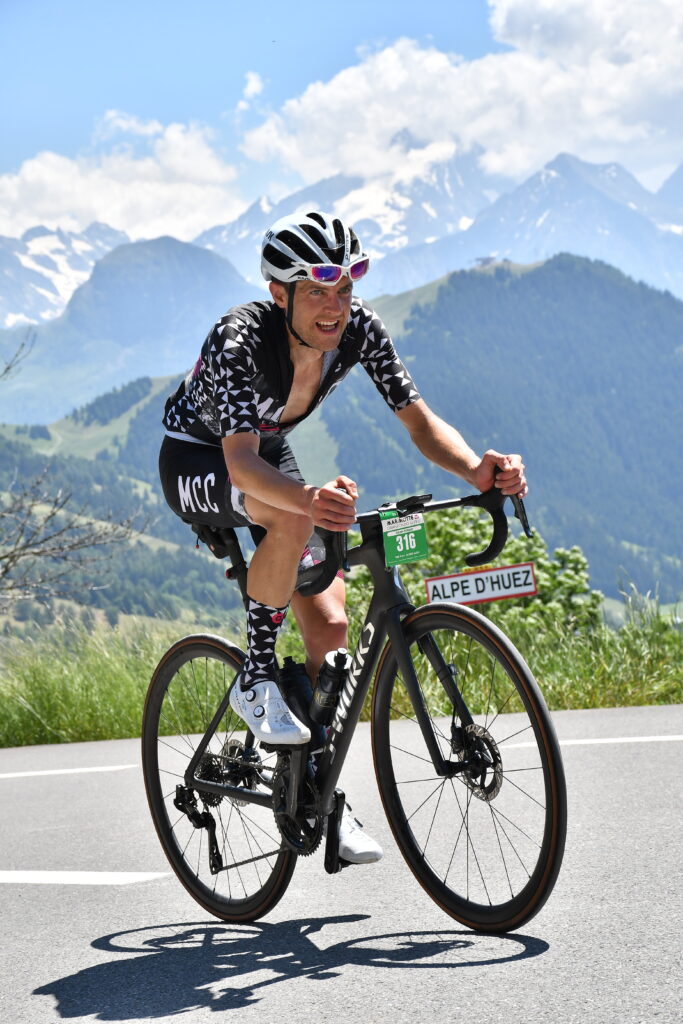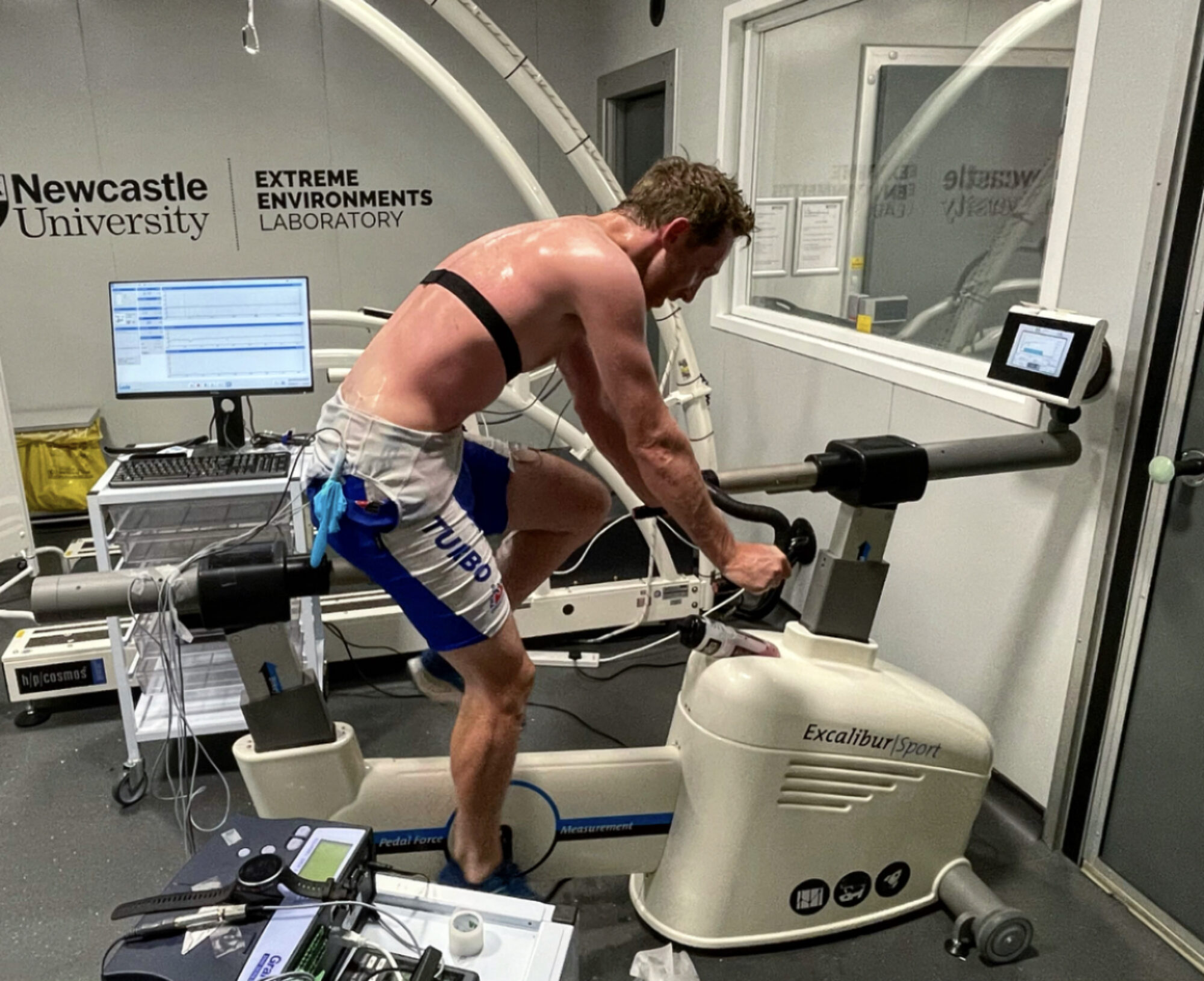Written by Lee Ager (PhD student)
La Marmotte Granfondo Alpes (aka “the Marmotte”) is considered one of the most prestigious and challenging Granfondo events in Europe. Held annually in June in the French Alps, it is a bucket list event for many cyclists attracting close to 5000 riders from around the world. The route typically requires riders to traverse the legendary mountain passes of the Col de la Croix de Fer, Col du Télégraphe, Col du Galibier and Alpe d’Huez, which frequently feature in the Tour de France. A late route change meant the 2023 edition was set to be even longer and tougher than usual, with the addition of the Col du Mollard. This resulted in a 186km route packed with over 5500m of elevation gain and topping out at a maximum altitude of 2650m (Col du Galibier).

In addition to the terrain, what can make the Marmotte especially challenging is the environmental conditions and in particular the heat. The negative impact of high temperature on endurance performance is well established and the increased cardiovascular strain is inevitably a major contributor to the huge number of DNFs each year.
When contemplating the various demands of the Marmotte, training aside, one area I knew I needed specific preparation for was the potential for hot conditions. My training is based in North-East England and, although picturesque, periods of hot and sunny weather are somewhat of a rarity. I knew I needed to improvise. This offered the perfect opportunity to combine my research interests in thermal physiology with my passion for cycling and get to work on implementing a heat acclimation strategy around my training.
What are the benefits of Heat Acclimation?
Repeated exposure to artificial heat stress known as heat acclimation (HA) is a strategy commonly adopted by athletes looking to compete in hot conditions to mitigate the deleterious impact of extreme heat on performance. Research supports positive physiological adaptions in response to heat stress which are observed in a matter of days with the vast majority of adaption typically being achieved in ~10 to 14 sessions of 60 to 120 minutes of exposure. Beneficial adaptions include increased plasma volume, increased sweat rate, reduced resting core temperature (Tc), thermal comfort and lowering of heart rate during exercise (Tyler et al, 2016). This reduces cardiovascular strain and increases thermal tolerance during heat exposure, both of which are important in maximising endurance performance in the heat. Anecdotally it appears that many amateur athletes are unaware that such potentially significant performance benefits can be gained from relatively little time commitment in their overall training programme.
My HA strategy for La Marmotte
For my own HA strategy, I aimed to complete 10 sessions over the course of 10 – 14 days, opting for a combination of both active and passive HA. Daily versus intermittent exposure may be important as less frequent exposure has been shown to be less effective than consecutive days for HA adaption (Gill & Sleivert, 2001). In terms of sequencing, my thinking was I’d perform active HA first, further out from the event, and use passive HA during taper to reduce the additional workload on the legs. For the active HA I used a combination of cycling sessions within our environmental chamber (EC) in hot conditions and moderate humidity (40°C, 40%RH) (figure 2) in conjunction with sessions that I performed at home.

The active home session, I termed “DIY” HA, were performed on an indoor trainer in a heated room while wearing thermal and vapor resistant clothing. The active DIY HA was a new one for me. For many years we have heard of athletes training in additional layers of clothing as a low-cost way to seek to improve their thermal tolerance however with little available evidence to support. Recently more research has investigated the potential efficacy of this as a valid HA method with promising results (Lundby et al, 2021). With this in mind, and in conjunction with the pure intrigue of determining whether performing HA in your own kitchen dressed in two layers of winter cycling kit (including a woolly hat) and using an electric fan heater, could replicate the Tc response seen in the EC…. I had to give it a shot.
For both active HA sessions I adopted an iso-thermic (controlled hyperthermia) protocol which involved an initial period of more intense cycling to ramp up Tc quickly, then reducing the intensity once Tc reached ~38.5C. I then attempted to maintain this within 38.5 to 39.5°C by regulating power output and feel. From a practical point of view, I saw two distinct advantages of this method. Firstly, it ensured maximal time spent in the proposed “optimal” Tc range for adaption (~38.5°C). Secondly, it would induce less fatigue as opposed to a fixed workload given the ‘maintenance’ power requirement to stay over 38.5°C is rather low. When comparing methods, I found the DIY HA more taxing both physically and mentally, partly from the increased power output required due to the lower ambient temperature of my room (~25°C) versus the EC (40°C). Had I been able to achieve a greater room temperature at home this gap would have been smaller, however the DIY method was still effective at increasing Tc to the desired level.
For passive HA I opted for hot water immersion (HWI) due to the convenience of requiring only a bathtub. As the bathtub would cool over time I opted for a little higher temperature initially than we would commonly use in the lab and adopted ~44°C. Recent published evidence suggests it can be at least as effective as active protocols particularly when performed post-exercise (McIntyre et al, 2021). By incorporating this method, I was able to take advantage of the already elevated Tc from exercise which meant a greater percentage of time spent under the required heat strain and increasing time-efficiency vs active methods. Figure 3 below shows the typical Tc response for each of the three protocols. For the HWI I continued to monitor after I began to drain the water and lay until Tc had fallen below 38.5°C, hence the ‘n’-shape data. Overall, I performed 3x Active EC (60-120min), 4x Active DIY at home (60-90min) and 3x HWI at home (40-60min).

As not everyone has access to an environmental chamber, I thought it may be interesting to note for any amateur athletes interested in some ‘DIY’ HA, that I only completed three sessions in the EC and the other seven sessions I completed at home. It is important to state here that from a health and safety point of view, I had someone close by at all times when performing my HA sessions both when in the EC and also at home. The importance of this cannot be stressed enough as there is inevitably an increased level of risk associated with working hard at significantly elevated Tc and tipping into heat stress territory.
Race day
The forecast for race day was hot and dry. After a cool humid start at 7am, the temperature was close to 30°C by midday with an average relative humidity of ~50%. The additional airflow when riding at faster speeds meant the high temperatures felt very manageable through the valleys however it was while climbing the temperature really became apparent. The reduction in air velocity at a relatively slow cycling speed meant less evaporative and convective cooling capacity. In combination with increased metabolic heat production from a higher power output, it presented a significantly greater thermoregulatory challenge than riding on flat and rolling terrain. This was nowhere more noticeable than on the lower slopes of Alpe d’Huez where temperatures peaked out at 36°C. It was here where I felt the HA really paid off and it was a confidence booster knowing I had done some preparation for this.
The percentage of total sweat produced versus that which evaporates from the skin is termed sweat efficiency (Seff) and only sweat which evaporates (and not drips) from the skin has a cooling effect. With sweat now dripping off from most parts of my body it was apparent the benefits of an increase in sweat rate from my HA work was being hampered due to the environmental conditions and a reduced Seff. For any thermal physiology researcher this is basic knowledge, yet it’s interesting to experience in a real-world context.

Overall, it took me ~7.5hrs total time to complete the route finishing 68th of the ~4500 riders (780 DNF!) and I would comfortably say it was the hardest cycling event I have taken part in. Figure 5 shows some performance data from the event.

Figure 6 shows some data from the Marmotte including ambient temperature (Tamb), heart rate, altitude and core body temperature (estimated using a CORE wearable device). For those who are unfamiliar, the CORE wearable is a small device which sits against the skin and aims to measure heat flux from the body. In conjunction with heart rate it uses an algorithm to noninvasively estimate core body temperature. Further information can be found on the company website at https://corebodytemp.com. We have been playing about with these devices in the lab and I decided to wear one for the event on my heart rate strap and see what the data looked like. According to the CORE unit I started at a Tc of ~ 37.1°C which quickly increased, as I started riding, to ~38.2°C on the first two climbs and dropped again while descending. The CORE device modelled the Tc increasing as the day went on which was associated with increased ambient temperature and heart rate. The peak Tc was recorded while ascending Alpe d’Huez where Tc was estimated at 38.6°C when ambient temperature was at its highest, however, unlike on the previous climb, Tc gradually dropped over the final 30 minutes to the finish line. One thing which may have contributed was after 3 kilometres of climbing I was dousing myself heavily with very cold water I had collected from the last aid station, so whether this impacted the accuracy of the unit I am unsure.

The Marmotte certainly lived up to expectations. It is both stunningly beautiful and unforgivingly brutal, especially so for riders accustomed to the weather and terrain of the UK! So if you are up for a real challenge and a bit of sweating, I’d highly recommend it.
Lee
References
Weather
https://www.wunderground.com/history/daily/fr/saint-étienne-de-saint-geoirs/LFLS/date/2023-6-25
Race Results
Related Literature
Gibson, O. R., James, C. A., Mee, J. A., Willmott, A. G. B., Turner, G., Hayes, M., & Maxwell, N. S. (2019). Heat alleviation strategies for athletic performance: A review and practitioner guidelines. Temperature (Austin, Tex.), 7(1), 3–36. https://doi.org/10.1080/23328940.2019.1666624
Gill, N., & Sleivert, G. (2001). Effect of daily versus intermittent exposure on heat acclimation. Aviation, space, and environmental medicine, 72(4), 385–390 https://pubmed.ncbi.nlm.nih.gov/11318020
Lundby, C., Svendsen, I. S., Urianstad, T., Hansen, J., & Rønnestad, B. R. (2021). Training wearing thermal clothing and training in hot ambient conditions are equally effective methods of heat acclimation. Journal of science and medicine in sport, 24(8), 763–767. https://pubmed.ncbi.nlm.nih.gov/34175201/
McIntyre, R. D., Zurawlew, M. J., Oliver, S. J., Cox, A. T., Mee, J. A., & Walsh, N. P. (2021). A comparison of heat acclimation by post-exercise hot water immersion and exercise in the heat. Journal of science and medicine in sport, 24(8), 729–734. https://pubmed.ncbi.nlm.nih.gov/34116919/
Tyler, C. J., Reeve, T., Hodges, G. J., & Cheung, S. S. (2016). The Effects of Heat Adaptation on Physiology, Perception and Exercise Performance in the Heat: A Meta-Analysis. Sports medicine (Auckland, N.Z.), 46(11), 1699–1724. https://doi.org/10.1007/s40279-016-0538-5
